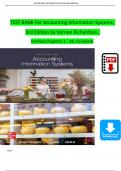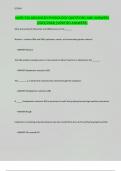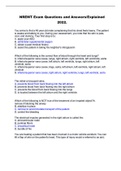ACCOUNTING INFORMATION SYSTEMS (RICHARDSON)
TEST BANK For Accounting Information Systems,
3rd Edition by Vernon Richardson,
Verified Chapters 1 - 18, Complete
Page 1
, ACCOUNTING INFORMATION SYSTEMS (RICHARDSON)
TABLE OF CONTENTS
Ch. 1 Accounting Information Systems and Firm Value
Ch. 2 Accountants as Business Analysts
Ch. 3 Data Modeling
Ch. 4 Relational Databases and Enterprise Systems
Ch. 5 Sales and Collections Business Process
Ch. 6 Purchases and Payments Business Process
Ch. 7 Conversion Business Process
Ch. 8 Integrated Project
Ch. 9 Reporting Processes and eXtensible Business Reporting Language (XBRL)
Ch. 10 Data Analytics in Accounting: Concepts and the AMPS Model
Ch. 11 Data Analytics in Accounting: Tools and Practice
Ch. 12 Emerging Technologies: Blockchain and AI Automation
Ch. 13 Accounting Information Systems and Internal Controls
Ch. 14 Information Security and Computer Fraud
Ch. 15 Monitoring and Auditing AIS
Ch. 16 The Balanced Scorecard, Business Model Canvas, and Business Value of Information Technology
Ch. 17 Evaluating AIS Investments
Ch. 18 Systems Development and Project Management for AIS
Page 2
, ACCOUNTING INFORMATION SYSTEMS (RICHARDSON)
Chapter 1 Accounting Information Systems and Firm Value
1) Accounting and Finance is a primary activity in the value chain.
ANSWER: FALSE
Diff: 1
Topic: The Value Chain and Accounting Information Systems
Learning Objective: 01-04 Describe how business processes affect the firm's value chain.
Bloom's: Remember
AACSB: Reflective Thinking
AICPA: BB Industry; FN Decision Making
2) Accounting Information Systems at this date are all
computerized. ANSWER: FALSE
Diff: 1
Topic: Data versus Information
Learning Objective: 01-02 Distinguish among data, information, and an information system.
Bloom's: Remember
AACSB: Reflective Thinking
AICPA: BB Industry; FN Decision Making
3) Business value includes all those items, events and interactions that determine the financial
health and well-being of the firm.
ANSWER: TRUE
Diff: 1
Topic: The Value Chain and Accounting Information Systems
Learning Objective: 01-04 Describe how business processes affect the firm's value chain.
Bloom's: Remember
AACSB: Reflective Thinking
AICPA: BB Industry; FN Decision Making
4) The Certified Information Technology Professional (CITP) is a professional designation for those
with a broad range of technology knowledge and does not require a CPA.
ANSWER: FALSE
Diff: 1
Topic: Role of Accountants in Accounting Information Systems
Learning Objective: 01-03 Distinguish the roles of accountants in providing information, and explain certifications
related to accounting information systems.
Bloom's: Remember AACSB:
Reflective Thinking
AICPA: BB Industry; FN Decision Making
5) The Certified Information Systems Auditor (CISA) is a professional designation generally sought
by those performing IT audits.
ANSWER: TRUE
Diff: 1
Page 3
, ACCOUNTING INFORMATION SYSTEMS (RICHARDSON)
Topic: Role of Accountants in Accounting Information Systems
Learning Objective: 01-03 Distinguish the roles of accountants in providing information, and explain certifications
related to accounting information systems.
Bloom's: Remember AACSB:
Reflective Thinking
AICPA: BB Industry; FN Decision Making
Page 4
, ACCOUNTING INFORMATION SYSTEMS (RICHARDSON)
6) Information is defined as being data organized in a meaningful way that is useful to the
user. ANSWER: TRUE
Diff: 1
Topic: Data versus Information
Learning Objective: 01-02 Distinguish among data, information, and an information system.
Bloom's: Remember
AACSB: Reflective Thinking
AICPA: BB Industry; FN Decision Making
7) Data is defined as being information organized in a meaningful way that is useful to the
user. ANSWER: FALSE
Diff: 1
Topic: Data versus Information
Learning Objective: 01-02 Distinguish among data, information, and an information system.
Bloom's: Remember
AACSB: Reflective Thinking
AICPA: BB Industry; FN Decision Making
8) A systems analyst analyzes a business problem that might be addressed by an information
system and recommends software or systems to address that problem.
ANSWER: TRUE
Diff: 1
Topic: The Value Chain and Accounting Information Systems
Learning Objective: 01-04 Describe how business processes affect the firm's value chain.
Bloom's: Remember
AACSB: Reflective Thinking
AICPA: BB Industry; FN Decision Making
9) A value chain is defined as the flow of materials, information, payments, and services
from customer to supplier.
ANSWER: FALSE
Diff: 1
Topic: The Value Chain and Accounting Information Systems
Learning Objective: 01-04 Describe how business processes affect the firm's value chain.
Bloom's: Remember
AACSB: Reflective Thinking
AICPA: BB Industry; FN Decision Making
10) Relevant information is that information that is free from bias and
error. ANSWER: FALSE
Diff: 1
Topic: Definition of Accounting Information Systems; Attributes of Useful Information
Learning Objective: 01-01 Define an accounting information system, and explain characteristics of useful information.
Bloom's: Remember
AACSB: Reflective Thinking
AICPA: BB Industry; FN Decision Making
Page 5
, ACCOUNTING INFORMATION SYSTEMS (RICHARDSON)
11) The characteristics of relevant information include predictive value, feedback value and
timeliness. ANSWER: TRUE
Diff: 1
Topic: Definition of Accounting Information Systems; Attributes of Useful Information
Learning Objective: 01-01 Define an accounting information system, and explain characteristics of useful information.
Bloom's: Remember
AACSB: Reflective Thinking
AICPA: BB Industry; FN Decision Making
12) The characteristics of reliable information are that the information is verifiable, without bias
and timely.
ANSWER: FALSE
Diff: 1
Topic: Definition of Accounting Information Systems; Attributes of Useful Information
Learning Objective: 01-01 Define an accounting information system, and explain characteristics of useful information.
Bloom's: Remember
AACSB: Reflective Thinking
AICPA: BB Industry; FN Decision Making
13) Information overload is defined as the difficulty a person faces in understanding a problem
and making a decision as a consequence of too much information.
ANSWER: TRUE
Diff: 1
Topic: Definition of Accounting Information Systems; Attributes of Useful Information
Learning Objective: 01-02 Distinguish among data, information, and an information system.
Bloom's: Remember
AACSB: Reflective Thinking
AICPA: BB Industry; FN Decision Making
14) The main financial benefit of Customer Relationship Management practices reduces the cost
of goods sold.
ANSWER: FALSE
Diff: 1
Topic: AIS, Firm Profitability, and Stock Prices
Learning Objective: 01-08 Assess the impact of AIS on firm profitability and stock prices.
Bloom's: Remember
AACSB: Reflective Thinking
AICPA: BB Industry; FN Decision Making
15) An efficient Enterprise System can significantly lower the cost of support processes included in
sales, general, and administrative expenses.
ANSWER: TRUE
Diff: 1
Topic: AIS, Firm Profitability, and Stock Prices
Learning Objective: 01-08 Assess the impact of AIS on firm profitability and stock prices.
Bloom's: Remember
AACSB: Reflective Thinking
AICPA: BB Industry; FN Decision Making
Page 6
, ACCOUNTING INFORMATION SYSTEMS (RICHARDSON)
16) An accounting information system (AIS) is defined as being an information system that records,
processes and reports on transactions to provide financial and nonfinancial information for
decision making and control.
ANSWER: TRUE
Diff: 1
Topic: Definition of Accounting Information Systems
Learning Objective: 01-01 Define an accounting information system, and explain characteristics of useful information.
Bloom's: Remember
AACSB: Reflective Thinking
AICPA: BB Industry; FN Decision Making
17) An enterprise system is a centralized database that collects data from throughout the firm.
This includes data from orders, customers, sales, inventory and employees.
ANSWER: TRUE
Diff: 1
Topic: AIS and Internal Business Processes
Learning Objective: 01-06 Describe how AIS assists the firm's internal business processes.
Bloom's: Remember
AACSB: Reflective Thinking
AICPA: BB Industry; FN Decision Making
18) Outbound logistics are the activities associated with receiving and storing raw materials and
other partially completed materials, and distributing those materials to manufacturing when
and where they are needed.
ANSWER: FALSE
Diff: 1
Topic: The Value Chain and Accounting Information Systems
Learning Objective: 01-04 Describe how business processes affect the firm's value chain.
Bloom's: Remember
AACSB: Reflective Thinking
AICPA: BB Industry; FN Decision Making
19) Service Activities as defined in the value chain are those activities that provide the support of
customers after the products and services are sold to them (e.g. warranty repairs, parts,
instruction manuals, etc.).
ANSWER: TRUE
Diff: 1
Topic: The Value Chain and Accounting Information Systems
Learning Objective: 01-04 Describe how business processes affect the firm's value chain.
Bloom's: Remember
AACSB: Reflective Thinking
AICPA: BB Industry; FN Decision Making
20) A well-designed and well-functioning AIS can be expected to create value by providing relevant
information helpful to management to increase revenues and reduce expenses.
ANSWER: TRUE
Diff: 1
Topic: AIS, Firm Profitability, and Stock Prices
Learning Objective: 01-08 Assess the impact of AIS on firm profitability and stock prices.
Bloom's: Remember
AACSB: Reflective Thinking
Page 7
, ACCOUNTING INFORMATION SYSTEMS (RICHARDSON)
AICPA: BB Industry; FN Decision Making
Page 8
, ACCOUNTING INFORMATION SYSTEMS (RICHARDSON)
21) Production of a 1040 tax form from the AIS to be delivered to the Internal Revenue Service is an
example of discretionary information.
ANSWER: FALSE
Diff: 1
Topic: Data versus Information
Learning Objective: 01-02 Distinguish among data, information, and an information system.
Bloom's: Remember
AACSB: Reflective Thinking
AICPA: BB Industry; FN Decision Making
22) An enterprise system is primarily used to manage and nurture a firm's interactions with its
current and potential clients.
ANSWER: FALSE
Diff: 1
Topic: AIS and Internal Business Processes
Learning Objective: 01-06 Describe how AIS assists the firm's internal business processes.
Bloom's: Remember
AACSB: Reflective Thinking
AICPA: BB Industry; FN Decision Making
23) The Sarbanes-Oxley Act of 2002 is a federal law in the United States that set new and
enhanced standards for all U.S. public companies, their management and public accounting
firms.
ANSWER: TRUE
Diff: 1
Topic: Role of Accountants in Accounting Information Systems
Learning Objective: 01-03 Distinguish the roles of accountants in providing information, and explain certifications
related to accounting information systems.
Bloom's: Remember AACSB:
Reflective Thinking
AICPA: BB Industry; FN Decision Making
24) CRM software often includes the use of database marketing tools to learn more about
the customers and to develop strong firm-to-customer relationships.
ANSWER: TRUE
Diff: 1
Topic: AIS and External Business Processes
Learning Objective: 01-07 Assess how AIS facilitates the firm's external business processes.
Bloom's: Remember
AACSB: Reflective Thinking
AICPA: BB Industry; FN Decision Making
25) The Certified Information Technology Professional is the position created by the AICPA to
recognize CPAs who have the ability to provide skilled professional services on Information
Technology.
ANSWER: TRUE
Diff: 1
Topic: Data versus Information
Learning Objective: 01-03 Distinguish the roles of accountants in providing information, and explain certifications
related to accounting information systems.
Bloom's: Remember AACSB:
Page 9
, ACCOUNTING INFORMATION SYSTEMS (RICHARDSON)
Reflective Thinking
AICPA: BB Industry; FN Decision Making
Page 10






